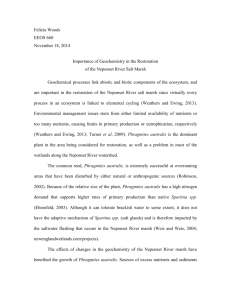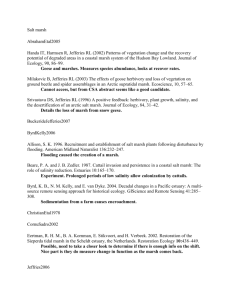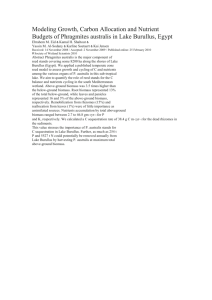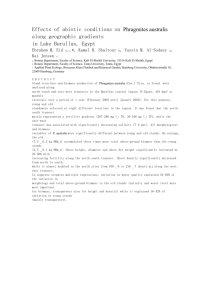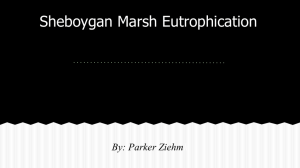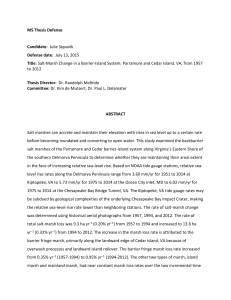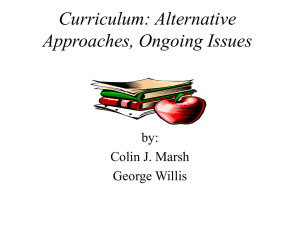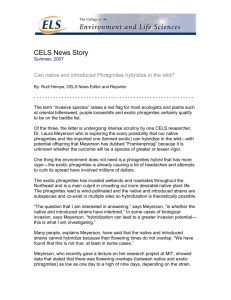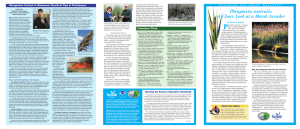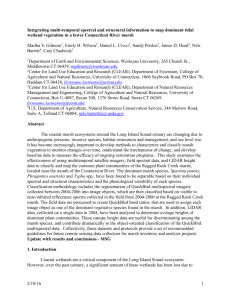EEOS_660_Woods_partII_Geochem - BIOEEOS660-f12
advertisement
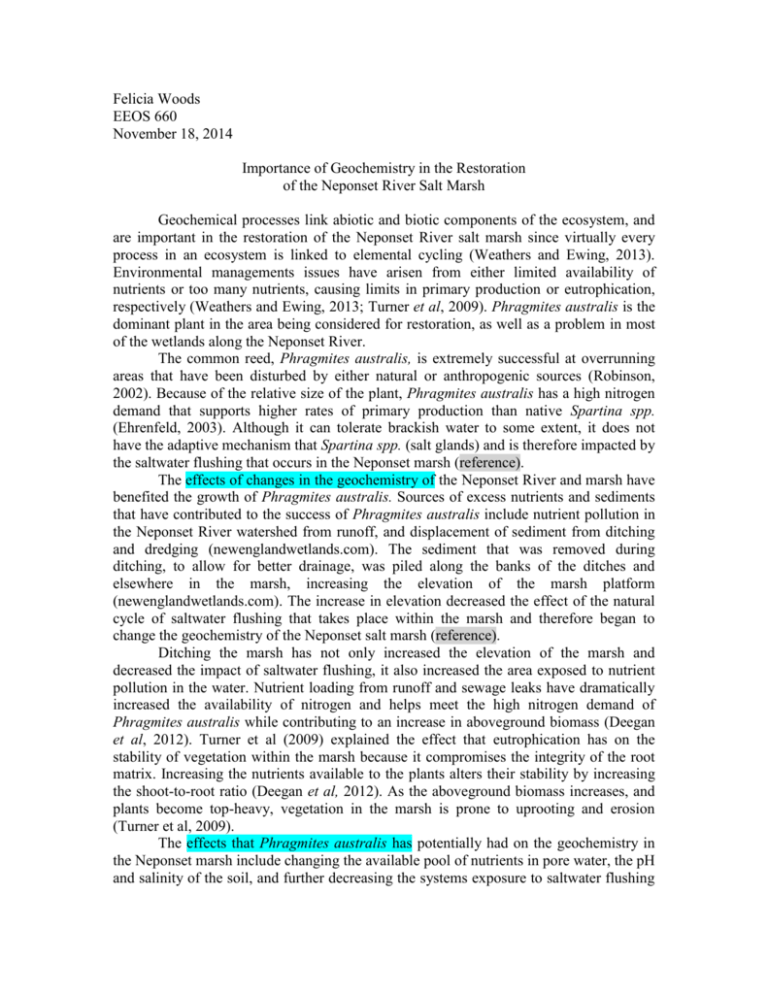
Felicia Woods EEOS 660 November 18, 2014 Importance of Geochemistry in the Restoration of the Neponset River Salt Marsh Geochemical processes link abiotic and biotic components of the ecosystem, and are important in the restoration of the Neponset River salt marsh since virtually every process in an ecosystem is linked to elemental cycling (Weathers and Ewing, 2013). Environmental managements issues have arisen from either limited availability of nutrients or too many nutrients, causing limits in primary production or eutrophication, respectively (Weathers and Ewing, 2013; Turner et al, 2009). Phragmites australis is the dominant plant in the area being considered for restoration, as well as a problem in most of the wetlands along the Neponset River. The common reed, Phragmites australis, is extremely successful at overrunning areas that have been disturbed by either natural or anthropogenic sources (Robinson, 2002). Because of the relative size of the plant, Phragmites australis has a high nitrogen demand that supports higher rates of primary production than native Spartina spp. (Ehrenfeld, 2003). Although it can tolerate brackish water to some extent, it does not have the adaptive mechanism that Spartina spp. (salt glands) and is therefore impacted by the saltwater flushing that occurs in the Neponset marsh (reference). The effects of changes in the geochemistry of the Neponset River and marsh have benefited the growth of Phragmites australis. Sources of excess nutrients and sediments that have contributed to the success of Phragmites australis include nutrient pollution in the Neponset River watershed from runoff, and displacement of sediment from ditching and dredging (newenglandwetlands.com). The sediment that was removed during ditching, to allow for better drainage, was piled along the banks of the ditches and elsewhere in the marsh, increasing the elevation of the marsh platform (newenglandwetlands.com). The increase in elevation decreased the effect of the natural cycle of saltwater flushing that takes place within the marsh and therefore began to change the geochemistry of the Neponset salt marsh (reference). Ditching the marsh has not only increased the elevation of the marsh and decreased the impact of saltwater flushing, it also increased the area exposed to nutrient pollution in the water. Nutrient loading from runoff and sewage leaks have dramatically increased the availability of nitrogen and helps meet the high nitrogen demand of Phragmites australis while contributing to an increase in aboveground biomass (Deegan et al, 2012). Turner et al (2009) explained the effect that eutrophication has on the stability of vegetation within the marsh because it compromises the integrity of the root matrix. Increasing the nutrients available to the plants alters their stability by increasing the shoot-to-root ratio (Deegan et al, 2012). As the aboveground biomass increases, and plants become top-heavy, vegetation in the marsh is prone to uprooting and erosion (Turner et al, 2009). The effects that Phragmites australis has potentially had on the geochemistry in the Neponset marsh include changing the available pool of nutrients in pore water, the pH and salinity of the soil, and further decreasing the systems exposure to saltwater flushing (Ehrenfeld, 2003; newenglandwetlands.com). The density Phragmites’ stems traps a considerable amount of sediment, further increasing the elevation and decreasing saltwater flushing. The reductions in water flow and flood retention caused by the increased sediment retention further impact nutrient cycling (Ehrenfeld, 2003). Changes in nutrient cycling can also result from changes in the biodiversity in the marsh. A decrease in the effectiveness of nutrient cycling can result from a decrease in biodiversity (Weathers and Ewing, 2013). The changes in nutrient cycling resulting from changes in dominant vegetative species in the marsh can contribute to variations in the microbial community (Ehrenfeld, 2003). Changes in the microbial community attributed to changes in nutrient inputs further alter the geochemistry of the marsh. The high nitrogen uptake of Phragmites australis increases denitrification rates in brackish marshes, such as the Neponset salt marsh, and affects the nitrogen pools in pore water (Ehrenfeld, 2003). By decreasing the pool of ammonium (NH4+) in pore water, it also contributes to changes in the pH of the soil of the marsh (Ehrenfeld, 2003). Both physical and physiological differences in Phragmites australis and Spartina spp. contribute to changes in soil salinity (Ehrenfeld, 2003). Physical differences contributing to changes in soil salinity when Phragmites australis invades areas natural to Spartina spp. include changes in ground shading. The taller, thicker biomass of Phragmites australis reduces evaporation because of the increase in ground cover (Ehrenfeld, 2003). The main physiological difference between the two species is the presence of salt excretion glands in Spartina spp.; Phragmites australis isn’t able translocate and excrete salt through its leaves. ***Most elements follow the same path as nutrient cycling and marshes have been proposed as potential sites for phytoremediation (Weathers and Ewing, 2013; Weis and Weis, 2004). Phrag sequesters more metals than Spartina because (Weis and Weis, 2004) Removal of Phragmites australis may reduce the rate of primary production in the marsh (Ehrenfeld), but it will definitely decrease phytoremediation of metals and other potentially toxic elements (Weis). ***While few previous projects have been done to manage the growth of Phragmites australis, the work done hasn’t had follow-up testing or observations taken to check on the success of the project. ***Very little research has been done on geochemistry in the Neponset River salt marsh and what has been done doesn’t include soil chemistry. Soil chemistry in the marsh may be an extremely important factor contributing to the success of any restoration attempts that will be made. References: Deegan, L., Johnson, D., Warren, R., Peterson, B., Fleeger, J., Fagherazzi, S., & Wollheim, W. (2012). Coastal eutrophication as a driver of salt marsh loss. Nature, 490, 388-392. Ehrenfeld, J. (2003). Effects of Exotic Plant Invasion on Soil Nutrient Cycling Processes. Ecosystems, (6), 503-523. http://www.falw.vu.nl/en/images/ehrenfeld_tcm24-80025.pdf Robinson, M. (2002). Common Reed: An Invasive Wetland Plant Phragmites australis. http://www.mass.gov/eea/docs/dcr/watersupply/lakepond/factsheet/phragmites.pd f Turner, R., Howes, B., Teal, J., Milan, C., Swenson, E., & Goehringer-Toner, D. (2009). Salt marshes and eutrophication: An unstable outcome. Limnology and Oceanography, 54(5), 1634-1642. Weathers, K., & Ewing, H. (2013). Element Cycling. In Fundamentals of Ecosystem Science (pp. 97-108). Amsterdam: Academic Press/Elsevier Weis, J., & Weis, P. (2003). Metal uptake, transport and release by wetland plants: Implications for phytoremediation and restoration. Environment International, 30, 685-700. http://newenglandwetlands.com/projects/
